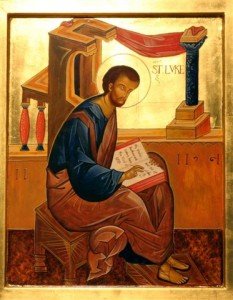 Scripture scholars maintain that Luke used Mark as a major source, as did Matthew, but in a different way. He included less of Mark – about 65 percent compared to Matthew’s 90 percent. And, rather than taking over large blocks of material from Mark and editing them only lightly, as Matthew most often did, Luke wove material from Mark together with his other sources. But his basic story line follows Mark’s threefold pattern of first Jesus’ activities in Galilee, second His journey to Jerusalem, and then, Jesus’ final days in the city of Jerusalem. Interestingly Luke expands the journey section from roughly three chapters in Mark and Matthew to nine chapters.
Scripture scholars maintain that Luke used Mark as a major source, as did Matthew, but in a different way. He included less of Mark – about 65 percent compared to Matthew’s 90 percent. And, rather than taking over large blocks of material from Mark and editing them only lightly, as Matthew most often did, Luke wove material from Mark together with his other sources. But his basic story line follows Mark’s threefold pattern of first Jesus’ activities in Galilee, second His journey to Jerusalem, and then, Jesus’ final days in the city of Jerusalem. Interestingly Luke expands the journey section from roughly three chapters in Mark and Matthew to nine chapters.
Like Matthew, Luke combined Mark with Q, editing and shaping both. In addition, again like Matthew, Luke has several hundred verses that are only in his gospel. Sometimes called special Luke, or simply “L”, this material includes stories of Jesus’ conception and birth and parables like the Good Samaritan, the Prodigal Son, the woman and the lost coin, the Pharisee and the Tax Collector, the Dishonest Steward and the widow and the unjust judge.
Luke shares the story of the empty tomb with Mark and Matthew. He also adds his own Easter stories, the most famous of which is Jesus appearing to two of his followers as an unrecognized stranger on the road to Emmaus. The gospel concludes with an ascension story, as does Matthew. But in Luke it happens just outside of Jerusalem, whereas in Matthew it occurs on a mountain in Galilee. Thus, even as Luke and Matthew both proclaim that Jesus is risen, they narrate this shared affirmation in different ways and place it in different locations.
Luke begins with two chapters about the birth of Jesus, as does Matthew. But they tell the stories in very different ways. Recall that Matthew’s is dominated by King Herod’s plot to kill Jesus. It echoes the story of Pharaoh’s attempt to kill Moses as an infant before the exodus from Egypt. It sets up Matthew’s theme of Jesus as the new Moses, the gospel as a new Pentateuch (the first five books of the Old Testament – the Torah) and what happened in Jesus as a new Exodus.
You will recall that our Easter Matins Service refers to Jesus as the new Moses and His resurrection as the new Exodus. Since the evangelists truly believed Jesus to be the awaited Messiah, He had to be the new Moses.
